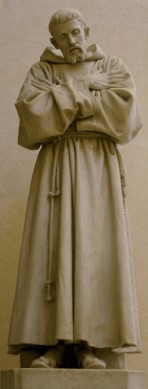Today, May 23rd, is the Feast of Saint's Eutizio, Spes, and Fiorenzo. I affectionately refer to these three as the Grandfathers of Western Monasticism since they would have had an influence on Saint Benedict, the Father of Western Monasticism, and Saint Scholastica. You can read about Sant'Eutizio, San Spes, and San Fiorenzo in my post from last year, here:
Feast of Saint Eutizio, Saint Fiorenzo, and Saint SpesAs I noted at the end of that post, I was disappointed that I did not have any pictures of my own from the monastery of Sant'Eutizio. Thankfully, that has changed. Last year, when I went to Norcia, Father Clement (who is now the pastor at Sant'Eutizio, which is now a parish) was kind enough to drive me there. It was a beautiful day and thankfully the church was open.
As a small historical note, the monastery of Sant'Eutizio was a rather important monastery back in the Middle Ages. It was related to the Monastery in Norcia, but apparently, Sant'Eutizio also had a lot of power back then. From what I was told, it controlled monasteries all the way to the western coast of Italy. Eventually it was abandoned when Napoleon came through Italy and kicked all the religious out of their monasteries and religious houses. This is why so many churches and monasteries in Italy are controlled or owned by the state.
Fortunately the diocese, and not the state, actually owns this land. The monastery has been used as a retreat center and the church is now a parish for the surrounding area. However, last year, the archbishop appropriately assigned one of the monks of Norcia as the pastor of the parish there.
I do love the place. A great memory was the first time I went to Norcia in 2000, Fr. Cassian, Fr. (then Br.) Clement, and I went to Sant'Eutizio and chanted the traditional Benedictine Vepsers in the choir in the church. It was a rather amazing experience.
Now back to last year's trip. First we had to get to Sant'Eutizio from Norcia. The drive there is about 15 minutes of amazing scenery around Norcia. You end up going over a pass "behind" Norcia and then into a valley area. There are about three or four little towns on the way to Sant'Eutizio. I'm always amazed at how some of the towns are just stuck on the side of a hill or mountain. Here's an example. I believe this is the small town of Piedivalle.

Eventually we leave the main road in the valley and head up to the monastery. Just above the monastery, again stuck to the side of the mountain, is Preci. I'm not sure if this is Preci proper, or just a small "upper part" of it. This is the view of it from the monastery.

Turning around we see the entrance to the monastery.

Which opens into the inner courtyard with the church to the right.

Inside the church, you can see an amazingly beautiful design where the high altar and choir are placed above the main level of the church.

Here we see the main altar, the crucifix and two busts of Sant'Eutizio and San Spes.

Going behind the altar we come into the choir and on the backside of the high altar area we see the reliquary.

The signs tells us (one in Italian and one in English) "Here rests the bodies of Sant'Eutizio and San Spes, Abbots, whose acts were written about by Pope Saint Gregory [the Great]."

Here's the choir I mentioned above. It's all woodwork, and although it's a bit hard to tell, there are actually two levels of choir stalls there.

Going outside we can see the bell tower built into the cliffside.

Turning to the right, we are looking at the facade of the church with a beautiful Romanesque rose window.

Just to get your bearings, here's the facade of the church and you can see the entrance to the monastery which we came through to the right.

Turning around and going up the side of the hill, we come to the cave where Sant'Eutizio lived.

And finally, after we leave and drive back towards Norcia, we come up over the pass and are able to look out upon Norcia itself.

So, I hope you enjoyed this little virtual tour of Sant'Eutizio and hope you feel a bit closer to them. They may be unknown, but in God's Providence, they have actually had a huge influence upon religious life in the West. If you don't know much about them, please read last year's post.

"Saint Spes and Saint Eutizio with Christ"

Saint Fiorenzo of Preci
I'm hoping that my friends at Norcia can help me learn more about these Saints.
RS











































